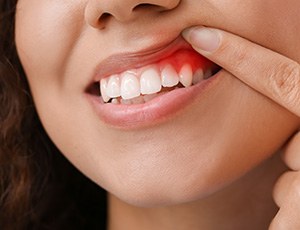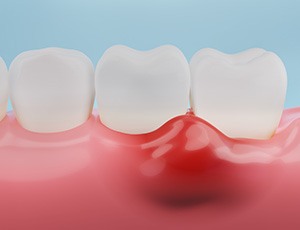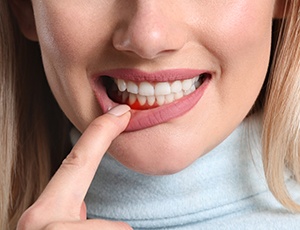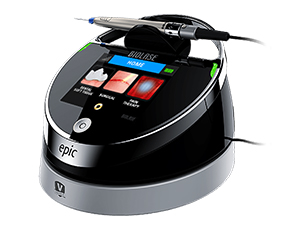Gum Disease Treatment – Richardson, TX
Preserving Your Gums’ Health
You may not have known, but the gums play a crucial role in oral health. Your mouth needs these tissues to support and protect your teeth, so your smile will suffer if they get infected. The good news is that we'll help you avoid that outcome with gum disease treatment in Richardson. With this service, our dentists will manage and heal your infected gums. Learn more about it by reading below or book your consultation today.
What is Gum Disease?

In essence, gum disease is an infection of your mouth’s gum tissue. It’s typically caused by an excess buildup of plaque, which often occurs due to a poor diet and bad dental care. Still, the disease has other risk factors as well – genetics, tobacco use, hormone changes, and more.
Gum disease develops in two distinct stages if not checked in time. The first is gingivitis – a mild (but painful) inflammation of the gums. What follows is periodontitis, a severe infection that directly attacks (and erodes) your jaw and gums.
Notably, the stage of gum disease affects treatment outcomes. Gingivitis can be reversed with proper dental care and good oral hygiene habits. In contrast, dentistry can’t eliminate periodontitis; it can only manage the condition.
Symptoms of Gum Disease

Since it has two possible stages, gum disease can cause various symptoms. The signs a patient shows will depend on their condition’s severity.
Take gingivitis, for instance. Its most common signs are:
- Halitosis (i.e., chronic bad breath)
- Gum tenderness
- Red, bleeding gums
- Swollen gums
- Gum recession
On the other hand, periodontitis often has harsher symptoms. These include:
- Chewing pain
- Tooth sensitivity (often due to gum recession)
- A shift in your bite
- Loose permanent teeth
- Permanent tooth loss
- Changes in your restoration’s fit
How Do We Treat Gum Disease?

Ahead of any treatment, our dentists will give you an oral exam to assess your mouth. This step lets us see the state of your gums – their sensitivity, inflammation, etc. We’ll then use our findings to suggest one (or more) of the following treatment options:
Scaling & Root Planing

Scaling and root planing is the ideal treatment choice for patients with moderate gum disease. Known as a deep cleaning, this nonsurgical periodontal solution involves thoroughly cleaning both above and below the gum line to prevent future infection. Our team will target the problem at the source and make sure you enjoy a healthy smile once again. Continue reading to learn more about the process and find out if this is the right option for you.
Do I Need Scaling & Root Planing?

At Cayon Creek Family Dentistry, we typically recommend scaling and root planing only when gum disease has progressed beyond the early stages. You may need this treatment if you’re experiencing symptoms like:
- Bleeding during brushing or flossing
- Gum recession
- Persistent bad breath or an unpleasant taste
- Shifting teeth
- Discomfort while chewing
- Noticeable plaque buildup
If you notice any of these signs, please contact our office promptly. We’ll carefully assess your gums to determine if scaling and root planing is necessary. The more advanced the infection, the more likely it is that this treatment will be required.
The Process of Scaling & Root Planing

Scaling and root planing is a two-part cleaning that removes the plaque and bacteria behind gum disease. For the initial “scaling”, we’ll thoroughly clean the areas underneath your gum tissue. We’ll then perform the “root planing” – a smoothing of your tooth roots to prevent further buildup of harmful microbes. That way, we can also ensure your gums successfully reattach to the roots for healthier results.
Aftercare Tips for Scaling & Root Planing

Following scaling and root planing, you might experience some discomfort along with mild swelling or bleeding in the treated area for a few days. Fortunately, these symptoms should fade on their own. We’ll schedule a follow-up appointment in one to two weeks to monitor your healing progress.
Keep in mind that you can prevent gum disease by maintaining excellent oral hygiene at home (brushing twice daily, flossing daily) and seeing your dentist regularly for checkups and cleanings. However, if gum disease does develop, scaling and root planing is usually an effective way to promote healing and restore gum health efficiently.
Biolase® Soft Tissue Laser

Instead of (or along with) scaling and root planing, we may suggest our Biolase® Soft Tissue Laser treatment. This option uses focused laser light to treat and remove the diseased tissue from your mouth. Due to its high precision, it’s minimally invasive and sterilizes treatment sites as it works. That means it causes little (if any) bleeding and allows for a fairly quick recovery. Even better, the service can promote the regeneration of new and healthy tissue!
